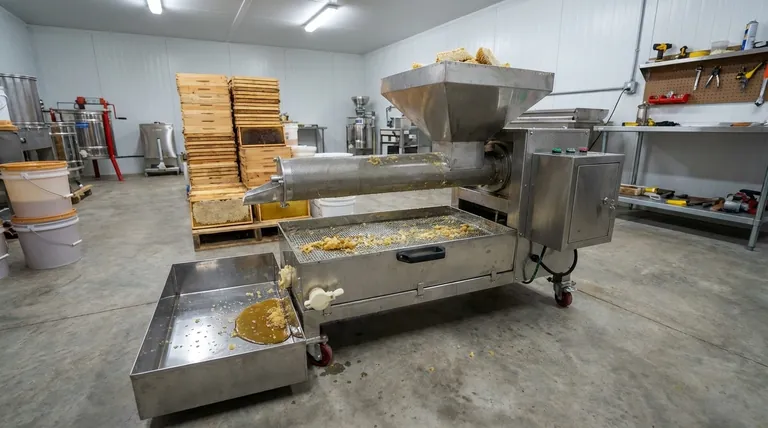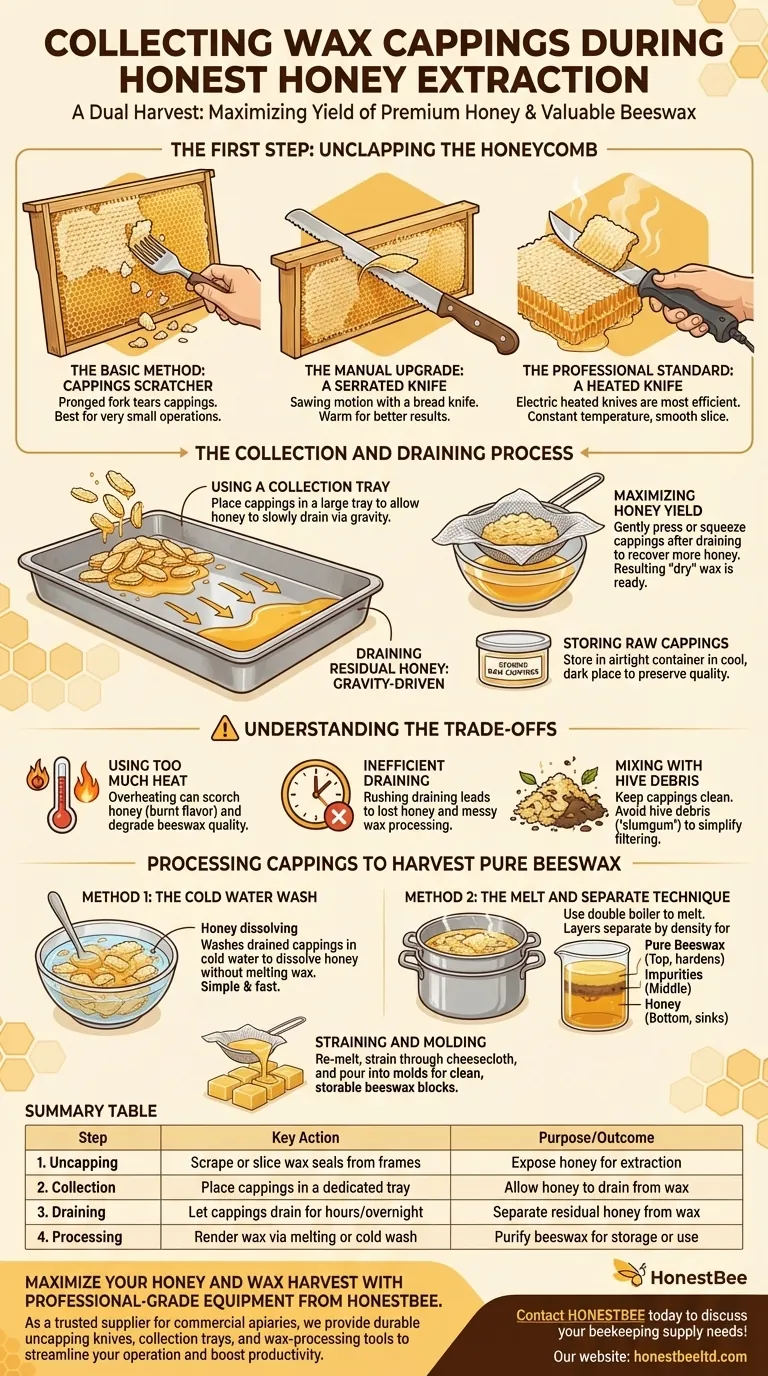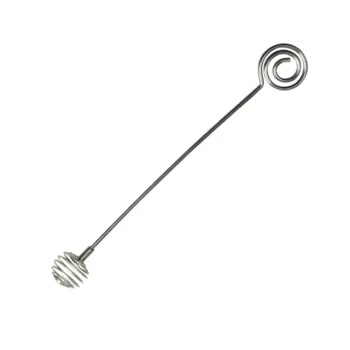During honey extraction, wax cappings are collected by first scraping them off the sealed honeycomb frames. These freshly removed cappings, which are saturated with honey, are then placed into a dedicated collection tray where the valuable residual honey can drain away from the wax.
Collecting wax cappings is not a clean-up chore, but an opportunity to harvest valuable beeswax. The central challenge is not in the collection itself, but in the subsequent process of efficiently separating the wax from the significant amount of honey trapped within it.

The First Step: Uncapping the Honeycomb
Before you can collect the cappings, you must first remove them from the frames. This process exposes the honey for extraction.
What Are Wax Cappings?
Wax cappings are the fresh, white beeswax seals that bees build over cells of cured honey. They are the final step in the bees' honey-making process, indicating the honey is ripe and ready for storage.
Essential Tools for Uncapping
The tool you choose will depend on the scale of your operation and your budget.
-
The Basic Method: Cappings Scratcher. A pronged, fork-like tool is effective for puncturing and tearing the cappings. This is best suited for a very small number of hives as it can be slow.
-
The Manual Upgrade: A Serrated Knife. A long, serrated bread knife can be used with a sawing motion to slice off the cappings. For better results, the knife can be periodically warmed in hot water.
-
The Professional Standard: A Heated Knife. Electric heated knives are the most efficient tool for uncapping. They maintain a constant temperature, allowing you to slice through the cappings smoothly and quickly with minimal effort.
The Collection and Draining Process
Once removed, the cappings must be handled properly to separate the honey from the wax. This two-part harvest is key to maximizing your yield.
Using a Collection Tray
Place the sliced cappings directly into a large metal or food-grade plastic tray. A simple oven tray or a dedicated uncapping tank works well.
The goal is to create a pile of cappings that allows the trapped honey to slowly drain to the bottom of the container, a process driven purely by gravity.
Draining the Residual Honey
A surprising amount of honey will be released from the cappings. Let them drain for several hours or even overnight.
To recover even more honey, you can gently press or squeeze the pile of cappings. The resulting "dry" wax is now ready for processing or storage.
Storing Raw Cappings
If you cannot process the wax immediately, store the drained cappings in an airtight container in a cool, dark place. This prevents pests and preserves the quality of the wax.
Understanding the Trade-offs
Proper technique is crucial for harvesting both high-quality honey and wax. Avoiding common mistakes will save time and improve your final product.
Using Too Much Heat
If using a heated knife, be careful not to set the temperature too high. Overheating can scorch the honey, introducing a burnt flavor, and can degrade the quality of the beeswax.
Inefficient Draining
Rushing the draining process is a common mistake that leads to lost honey. Be patient and allow gravity to do its work. Inadequate draining also makes the final wax-rendering process much messier.
Mixing with Hive Debris
Try to keep the cappings as clean as possible during collection. Avoid mixing in other hive debris or "slumgum," as this will complicate the filtering process required to get pure wax later on.
Processing Cappings to Harvest Pure Beeswax
Once the honey is drained, you are left with beeswax. This wax must be cleaned—or "rendered"—to be useful.
Method 1: The Cold Water Wash
For maximum simplicity, the drained cappings can be washed in cold water. The water dissolves any remaining honey without melting the wax. The cleaned wax can then be thoroughly dried and stored.
Method 2: The Melt and Separate Technique
For a purer result, use a double boiler to gently melt the cappings. As the mixture cools, it will separate into three distinct layers.
The pure, melted beeswax will float to the top and harden. The heavier honey will sink to the bottom. A layer of impurities will get trapped between them.
Straining and Molding
Once you have your melted, separated wax, you can perform a final purification step. Re-melt the wax and pour it through several layers of cheesecloth to filter out any remaining debris.
Pour the clean, liquid wax into molds to form convenient, easy-to-store beeswax blocks. These blocks can be used for countless applications, from making candles and cosmetics to coating new hive equipment.
Making the Right Choice for Your Goal
Your approach to collecting cappings should align with your primary objective.
- If your primary focus is maximum honey yield: Squeeze or press your cappings thoroughly before you begin processing the wax.
- If your primary focus is simplicity and speed: Use the cold water wash method to clean your wax for basic uses like coating hive equipment.
- If your primary focus is high-quality, pure beeswax: Use the melt-and-separate technique followed by careful straining to produce clean blocks for crafts, candles, or cosmetics.
By treating wax cappings as a valuable co-product rather than a waste material, you fully honor the work of your bees and maximize the rewards of your harvest.
Summary Table:
| Step | Key Action | Purpose/Outcome |
|---|---|---|
| 1. Uncapping | Scrape or slice wax seals from frames | Expose honey for extraction |
| 2. Collection | Place cappings in a dedicated tray | Allow honey to drain from wax |
| 3. Draining | Let cappings drain for hours/overnight | Separate residual honey from wax |
| 4. Processing | Render wax via melting or cold wash | Purify beeswax for storage or use |
Maximize your honey and wax harvest with professional-grade equipment from HONESTBEE.
As a trusted supplier for commercial apiaries and distributors, we provide durable, efficient uncapping knives, collection trays, and wax-processing tools designed to streamline your operation. Whether your goal is higher honey yields or premium beeswax, our wholesale-focused solutions help you work smarter.
Contact HONESTBEE today to discuss your beekeeping supply needs and boost your productivity!
Visual Guide

Related Products
- Honey Wax Separating Wax Press with Metal Screw Wax Separator Machine
- 10L Stainless Steel Honey Wax Press Extractor for Wax Cappings
- Stainless Steel Manual Honey Press with Guard for Pressing Honey and Wax
- Colorful Silicone Beeswax Foundation Mold Mould for Beekeeping
- Modern Stainless Steel Honey Dipper Stirrer
People Also Ask
- How can remaining honey be removed from wax cappings after straining? Maximize Your Harvest Yield
- What are the benefits of a Honey-Wax Separating Screw Press? Boost Honey Yield & Efficiency
- How does the honey screw press operate? A Guide to Maximizing Honey Yield from Cappings
- What happens to the remaining wax in the Wax Screw Presses set? A Guide to Efficient Honey & Wax Separation
- What equipment is used to separate beeswax from honey in cappings? Match the Right Tool to Your Apiary's Scale



















